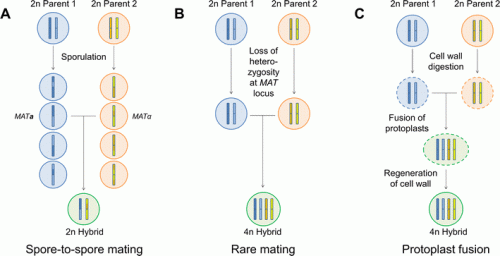I’m really sorry for not posting in this blog more actively. I haven’t really been homebrewing much the past year, since we moved to a new house that needed renovating. We’ve finally renovated the garage into a brewing space and home bar, so I will hopefully be posting more actively about homebrewing now. I actually even brewed two batches of beer here in the new house last weekend, and I’ll be posting an update of them along with some pictures of the new brewing space in a future post.
Besides homebrewing, I like to write about my own and other’s beer and yeast research on the blog. We have some really interesting yeast projects going on, which I hope to be able to share with you soon. In the meanwhile, we were invited to write a review article on the use of hybrid yeasts in brewing for Applied Microbiology and Biotechnology, and I’m happy to say that the article has been published online now. In it we sum up the research that has been done on the use of artificial or de novo yeast hybrids for brewing applications, and discuss what kind of benefits they have to the process. These include creating strains with improved aroma formation, fermentation rate and stress tolerance. There is also a short section on how to create these hybrids. Feel free to have a look if you are interested, the article is open access!
Here is a link to the article: http://link.springer.com/article/10.1007/s00253-016-8007-5
Abstract:
The natural interspecies Saccharomyces cerevisiae × Saccharomyces eubayanus hybrid yeast is responsible for global lager beer production and is one of the most important industrial microorganisms. Its success in the lager brewing environment is due to a combination of traits not commonly found in pure yeast species, principally low-temperature tolerance, and maltotriose utilization. Parental transgression is typical of hybrid organisms and has been exploited previously for, e.g., the production of wine yeast with beneficial properties. The parental strain S. eubayanus has only been discovered recently and newly created lager yeast strains have not yet been applied industrially. A number of reports attest to the feasibility of this approach and artificially created hybrids are likely to have a significant impact on the future of lager brewing. De novo S. cerevisiae × S. eubayanus hybrids outperform their parent strains in a number of respects, including, but not restricted to, fermentation rate, sugar utilization, stress tolerance, and aroma formation. Hybrid genome function and stability, as well as different techniques for generating hybrids and their relative merits are discussed. Hybridization not only offers the possibility of generating novel non-GM brewing yeast strains with unique properties, but is expected to aid in unraveling the complex evolutionary history of industrial lager yeast.

Looking forward to reading this, and nice work on the new garage!
I’ve seen a yeast company renaissanceyeast.com (brewersbright.com their brewers wing) say they can breed h2s traits out of yeast by breeding a new hybrid back with it’s old parents.
Do you think that’s possible with most traits?
Typo: http://www.brewingbright.com * (unfortunately almost the same name as jasper yeasts new company…)
Thanks for your comments! Backcrossing hybrids with their parents is quite a common practice yes for strengthening or weakening certain traits. There is definitely a lot that can be done with breeding 🙂
Read it last night, noticed you mentioned them! I should have held onto my tongue before posting :).
I don’t suppose this is really possible to do at a home scale is it? Either lots of media is required or/and specialist equipment.
Did you come across this paper when writing it? http://onlinelibrary.wiley.com/doi/10.1002/j.2050-0416.1951.tb01622.x/epdf